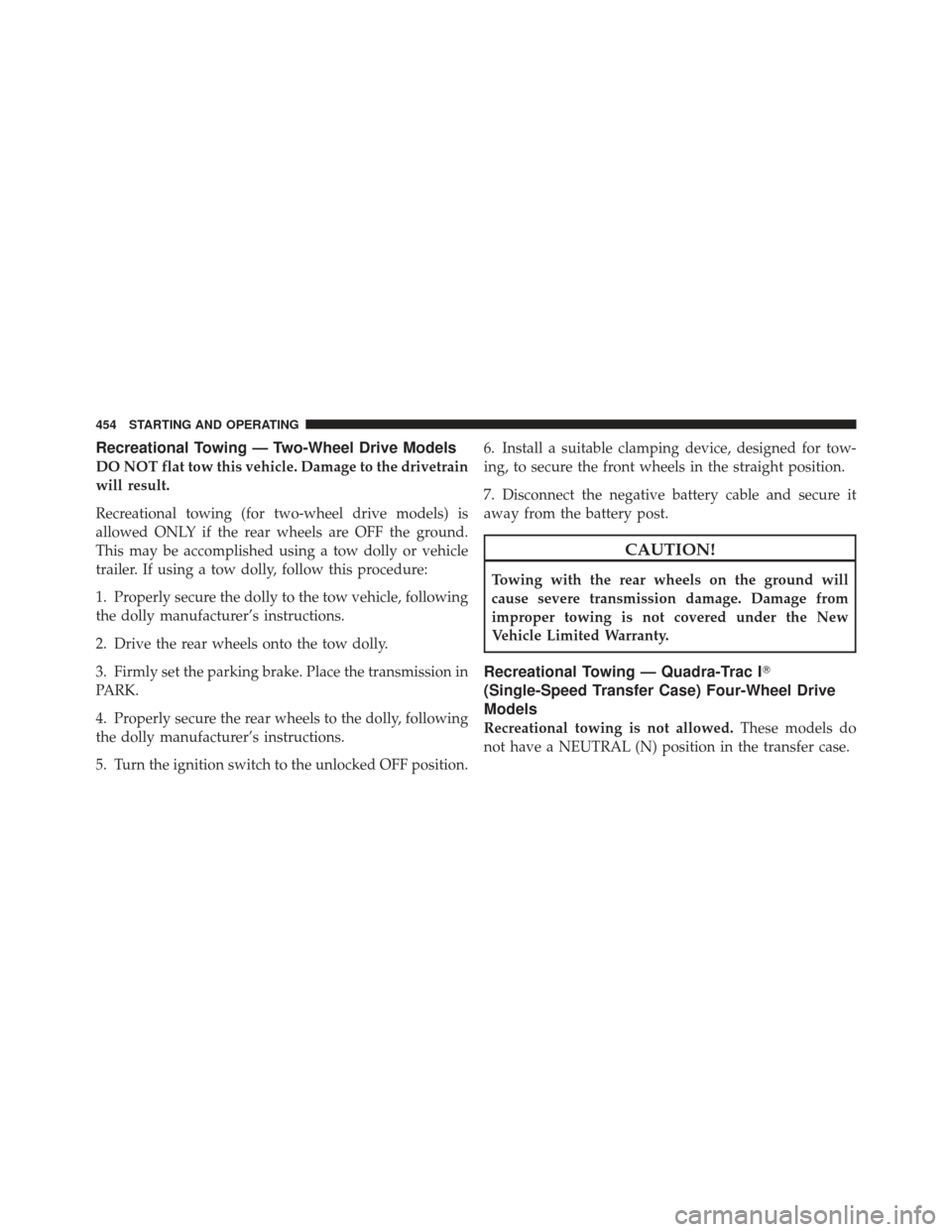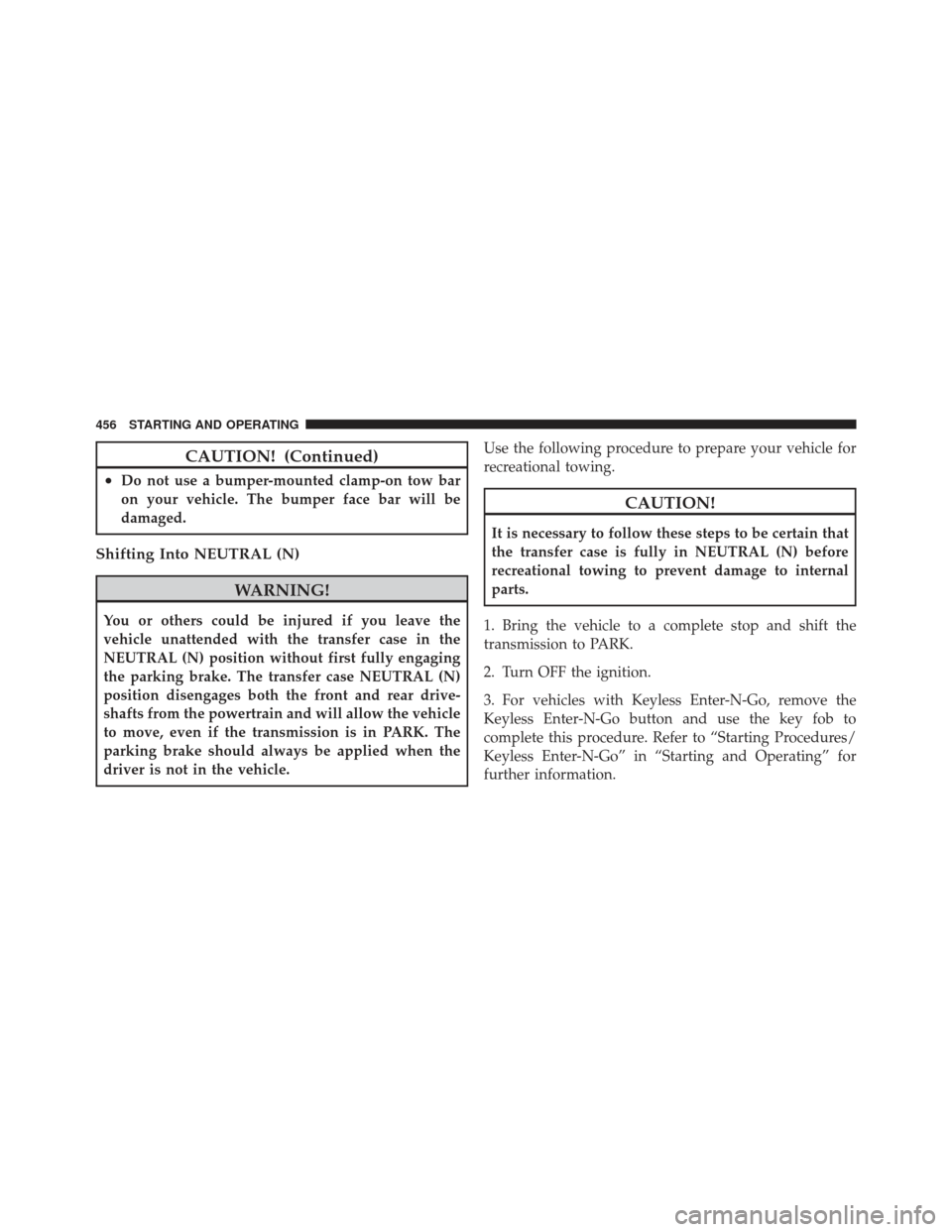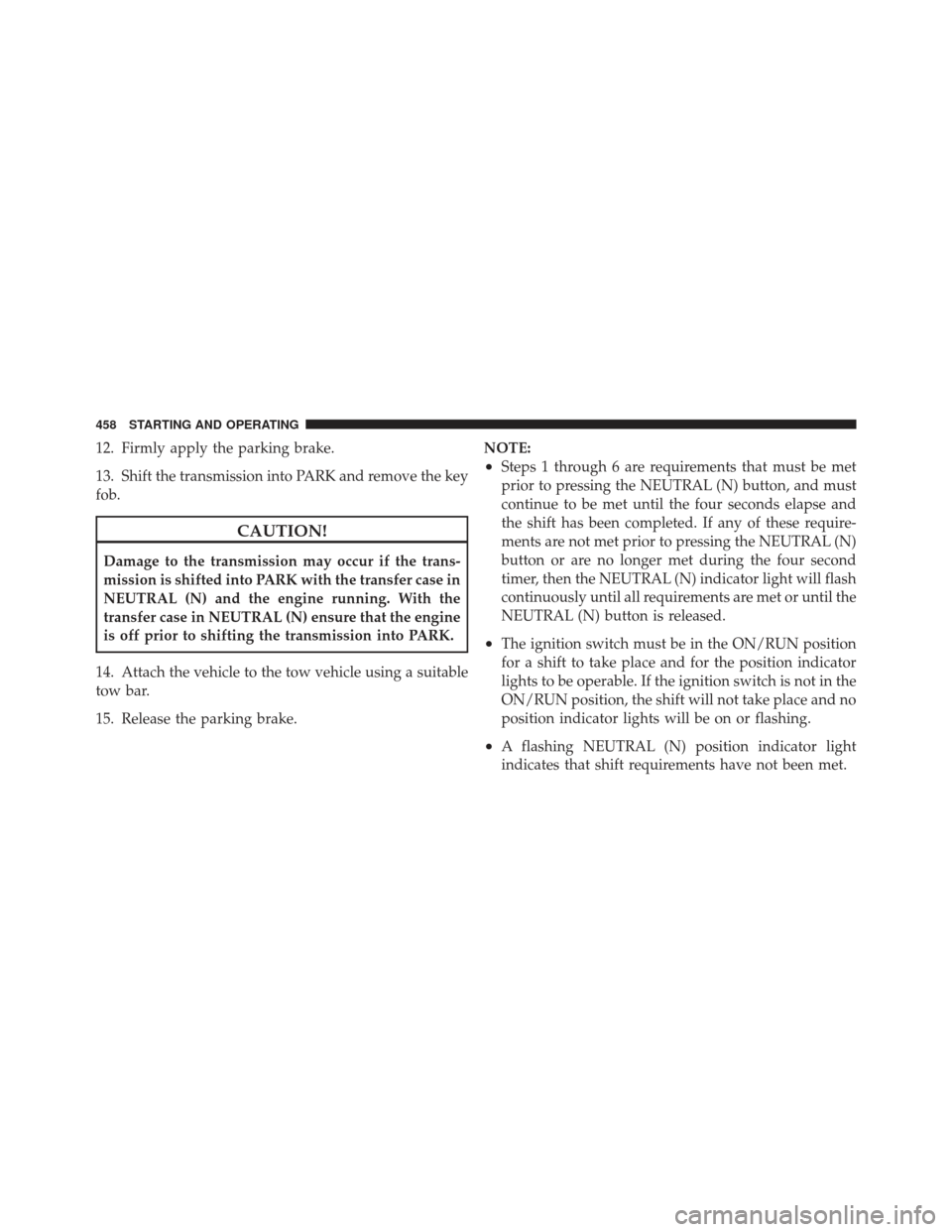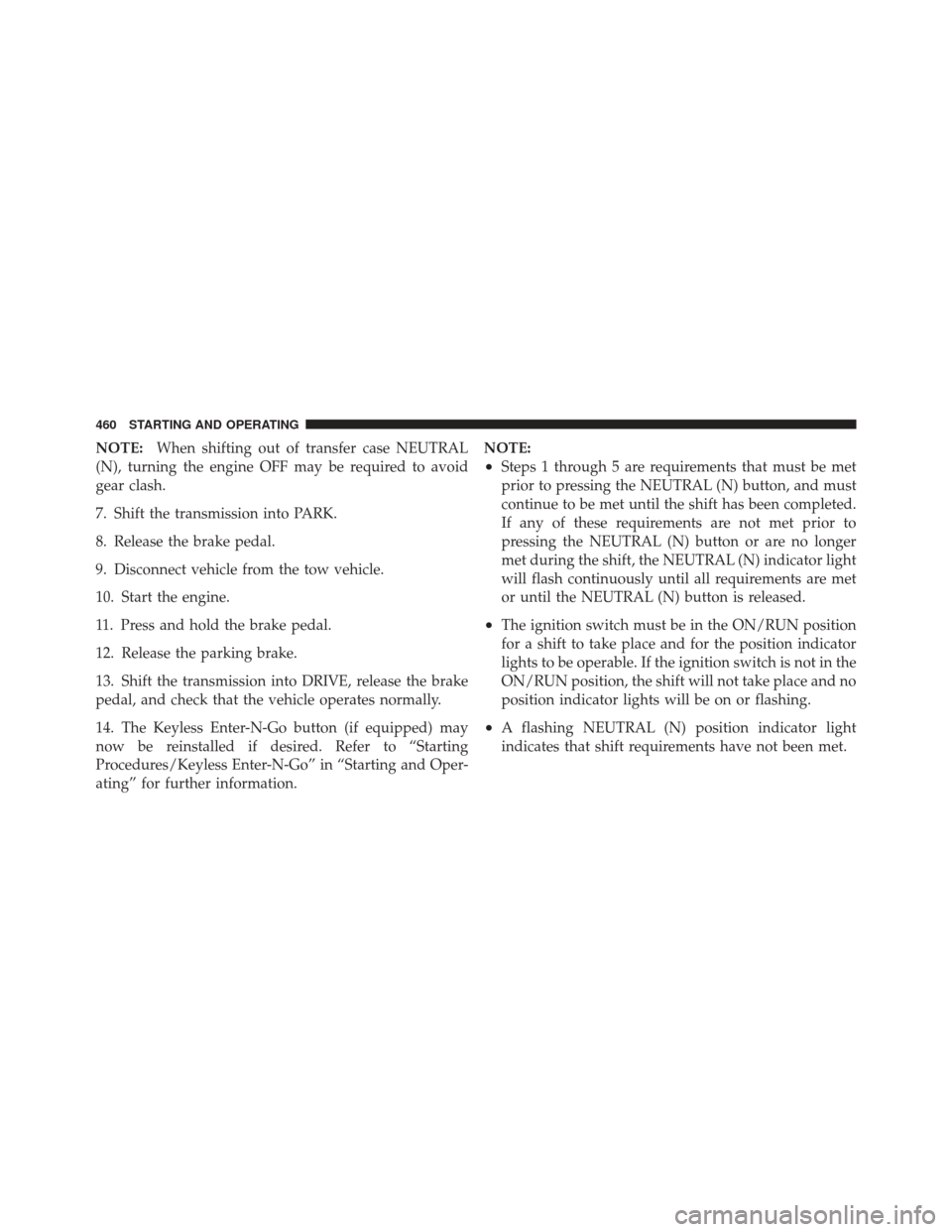Page 456 of 587

Recreational Towing — Two-Wheel Drive Models
DO NOT flat tow this vehicle. Damage to the drivetrain
will result.
Recreational towing (for two-wheel drive models) is
allowed ONLY if the rear wheels are OFF the ground.
This may be accomplished using a tow dolly or vehicle
trailer. If using a tow dolly, follow this procedure:
1. Properly secure the dolly to the tow vehicle, following
the dolly manufacturer’s instructions.
2. Drive the rear wheels onto the tow dolly.
3. Firmly set the parking brake. Place the transmission in
PARK.
4. Properly secure the rear wheels to the dolly, following
the dolly manufacturer’s instructions.
5. Turn the ignition switch to the unlocked OFF position.6. Install a suitable clamping device, designed for tow-
ing, to secure the front wheels in the straight position.
7. Disconnect the negative battery cable and secure it
away from the battery post.
CAUTION!
Towing with the rear wheels on the ground will
cause severe transmission damage. Damage from
improper towing is not covered under the New
Vehicle Limited Warranty.
Recreational Towing — Quadra-Trac I
�
(Single-Speed Transfer Case) Four-Wheel Drive
Models
Recreational towing is not allowed. These models do
not have a NEUTRAL (N) position in the transfer case.
454 STARTING AND OPERATING
Page 458 of 587

CAUTION! (Continued)
•Do not use a bumper-mounted clamp-on tow bar
on your vehicle. The bumper face bar will be
damaged.
Shifting Into NEUTRAL (N)
WARNING!
You or others could be injured if you leave the
vehicle unattended with the transfer case in the
NEUTRAL (N) position without first fully engaging
the parking brake. The transfer case NEUTRAL (N)
position disengages both the front and rear drive-
shafts from the powertrain and will allow the vehicle
to move, even if the transmission is in PARK. The
parking brake should always be applied when the
driver is not in the vehicle.Use the following procedure to prepare your vehicle for
recreational towing.
CAUTION!
It is necessary to follow these steps to be certain that
the transfer case is fully in NEUTRAL (N) before
recreational towing to prevent damage to internal
parts.
1. Bring the vehicle to a complete stop and shift the
transmission to PARK.
2. Turn OFF the ignition.
3. For vehicles with Keyless Enter-N-Go, remove the
Keyless Enter-N-Go button and use the key fob to
complete this procedure. Refer to “Starting Procedures/
Keyless Enter-N-Go” in “Starting and Operating” for
further information.
456 STARTING AND OPERATING
Page 459 of 587
4. Turn the ignition switch to the ON/RUN position, but
do not start the engine.
5. Press and hold the brake pedal.
6. Shift the transmission into NEUTRAL.
7. Using the point of a ballpoint pen or similar object,
press and hold the recessed transfer case N (Neutral)
button (located by the selector switch) for four seconds,
until the light behind the N symbol starts to blink,
indicating shift in progress. The light will stop blinking
(stay on solid) when the shift to N (Neutral) is complete.
A “FOUR WHEEL DRIVE SYSTEM IN NEUTRAL” mes-
sage will display on the EVIC (Electronic Vehicle Infor-
mation Center). Refer to “Electronic Vehicle Information
Center (EVIC)” in “Understanding Your Instrument
Panel” for further information.8. Start the engine.
9. Shift the transmission into REVERSE.
10. Release the brake pedal for five seconds and ensure
that there is no vehicle movement.
11. Turn OFF the engine.
Neutral Switch
5
STARTING AND OPERATING 457
Page 460 of 587

12. Firmly apply the parking brake.
13. Shift the transmission into PARK and remove the key
fob.
CAUTION!
Damage to the transmission may occur if the trans-
mission is shifted into PARK with the transfer case in
NEUTRAL (N) and the engine running. With the
transfer case in NEUTRAL (N) ensure that the engine
is off prior to shifting the transmission into PARK.
14. Attach the vehicle to the tow vehicle using a suitable
tow bar.
15. Release the parking brake. NOTE:
•Steps 1 through 6 are requirements that must be met
prior to pressing the NEUTRAL (N) button, and must
continue to be met until the four seconds elapse and
the shift has been completed. If any of these require-
ments are not met prior to pressing the NEUTRAL (N)
button or are no longer met during the four second
timer, then the NEUTRAL (N) indicator light will flash
continuously until all requirements are met or until the
NEUTRAL (N) button is released.
•The ignition switch must be in the ON/RUN position
for a shift to take place and for the position indicator
lights to be operable. If the ignition switch is not in the
ON/RUN position, the shift will not take place and no
position indicator lights will be on or flashing.
•A flashing NEUTRAL (N) position indicator light
indicates that shift requirements have not been met.
458 STARTING AND OPERATING
Page 462 of 587

NOTE:When shifting out of transfer case NEUTRAL
(N), turning the engine OFF may be required to avoid
gear clash.
7. Shift the transmission into PARK.
8. Release the brake pedal.
9. Disconnect vehicle from the tow vehicle.
10. Start the engine.
11. Press and hold the brake pedal.
12. Release the parking brake.
13. Shift the transmission into DRIVE, release the brake
pedal, and check that the vehicle operates normally.
14. The Keyless Enter-N-Go button (if equipped) may
now be reinstalled if desired. Refer to “Starting
Procedures/Keyless Enter-N-Go” in “Starting and Oper-
ating” for further information. NOTE:
•Steps 1 through 5 are requirements that must be met
prior to pressing the NEUTRAL (N) button, and must
continue to be met until the shift has been completed.
If any of these requirements are not met prior to
pressing the NEUTRAL (N) button or are no longer
met during the shift, the NEUTRAL (N) indicator light
will flash continuously until all requirements are met
or until the NEUTRAL (N) button is released.
•The ignition switch must be in the ON/RUN position
for a shift to take place and for the position indicator
lights to be operable. If the ignition switch is not in the
ON/RUN position, the shift will not take place and no
position indicator lights will be on or flashing.
•A flashing NEUTRAL (N) position indicator light
indicates that shift requirements have not been met.
460 STARTING AND OPERATING
Page 463 of 587
WHAT TO DO IN EMERGENCIES
CONTENTS
�Hazard Warning Flashers ................ 462
� If Your Engine Overheats ................ 462
� Jacking And Tire Changing ............... 463
▫ Jack Location ....................... 464
▫ Spare Tire Stowage ................... 464
▫ Preparations For Jacking ............... 465
▫ Jacking Instructions ................... 466 �
Jump-Starting ........................ 471
▫ Preparations For Jump-Start ............. 472
▫ Jump-Starting Procedure ............... 473
� Emergency Tow Hooks — If Equipped ...... 475
� Shift Lever Override ................... 476
� Towing A Disabled Vehicle ............... 477
▫ Towing Without The Ignition Key FOB ..... 479
▫ Two-Wheel Drive Models .............. 479
▫ Four-Wheel Drive Vehicles .............. 480
6
Page 464 of 587

HAZARD WARNING FLASHERS
The Hazard Warning flasher switch is located on the
switch bank just above the climate controls.Press the switch to turn on the Hazard Warning
flasher. When the switch is activated, all directional
turn signals will flash on and off to warn oncoming
traffic of an emergency. Press the switch a second time to
turn off the Hazard Warning flashers.
This is an emergency warning system and it should not
be used when the vehicle is in motion. Use it when your
vehicle is disabled and it is creating a safety hazard for
other motorists.
When you must leave the vehicle to seek assistance, the
Hazard Warning flashers will continue to operate even
though the ignition is placed in the OFF position.
NOTE: With extended use the Hazard Warning flashers
may wear down your battery.
IF YOUR ENGINE OVERHEATS
In any of the following situations, you can reduce the
potential for overheating by taking the appropriate ac-
tion.
•On the highways — slow down.
•In city traffic — while stopped, place the transmission
in NEUTRAL, but do not increase the engine idle
speed.
NOTE: There are steps that you can take to slow down
an impending overheat condition:
•If your air conditioner (A/C) is on, turn it off. The A/C
system adds heat to the engine cooling system and
turning the A/C off can help remove this heat.
462 WHAT TO DO IN EMERGENCIES
Page 467 of 587
Preparations For Jacking
1. Park the vehicle on a firm, level surface. Avoid ice or
slippery surfaces.
WARNING!
Do not attempt to change a tire on the side of the
vehicle closest to moving traffic, pull far enough off
the road to avoid being hit when operating the jack
or changing the wheel.
2. Turn on the Hazard Warning flasher.
3. Set the parking brake.
4. Place the shift lever into PARK.
5. Turn the ignition OFF. 6. Block both the front and rear of the
wheel diagonally opposite of the jack-
ing position. For example, if changing
the right front tire, block the left rear
wheel.
NOTE: Passengers should not remain in the vehicle
when the vehicle is being jacked.
7. For vehicle equipped with Quadra-Lift� refer to
“Quadra-Lift — If Equipped” in “Starting and Operat-
ing” for further information on disabling automatic
leveling.
6
WHAT TO DO IN EMERGENCIES 465